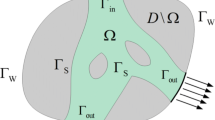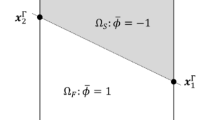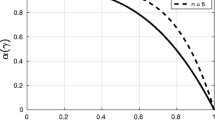Abstract
This paper studies topology optimization of convective heat transfer problems in two and three dimensions. The convective fluxes are approximated by Newton’s Law of Cooling (NLC). The geometry is described by a Level Set Method (LSM) and the temperature field is predicted by the eXtended Finite Element Method (XFEM). A constraint on the spatial gradient of the level set field is introduced to penalize small, sub-element-size geometric features. Numerical studies show that the LSM-XFEM provides improved accuracy over previously studied density methods and LSMs using Ersatz material models. It is shown that the NLC model with an iso-thermal fluid phase may over predict the convective heat flux and thus promote the formation of very thin fluid channels, depending on the Biot number characterizing the heat transfer problem. Approximating the temperature field in the fluid phase by a diffusive model mitigates this issue but an explicit feature size control is still necessary to prevent the formation of small solid members, in particular at low Biot numbers. The proposed constraint on the gradient of the level set field is shown to suppress sub-element-size features but necessitates a continuation strategy to prevent the optimization process from stagnating as geometric features merge.






















Similar content being viewed by others
References
Alexandersen J (2011) Topology optimization for convection problems. Master’s thesis, DTU Mekanik
Alexandersen J, Aage N, Andreasen C S, Sigmund O (2014) Topology optimisation for natural convection problems. Int J Numer Methods Fluids 76(10):699–721
Allaire G, Jouve F, Toader A M (2004) Structural optimization using sensitivity analysis and a level-set method. J Comput Phys 194(1):363–393. doi:10.1016/j.jcp.2003.09.032
Bendsøe M (1989) Optimal shape design as a material distribution problem. Struct Multidiscip Optim 1 (4):193–202. doi:10.1007/BF01650949
Bendsøe MP, Sigmund O (2003) Topology Optimization: Theory, Methods and Applications. Springer
Bourdin B (2001) Filters in topology optimization. Int J Numer Methods Eng 50(9):2143–2158
Bruns T (2007) Topology optimization of convection-dominated, steady-state heat transfer problems. Int J Heat Mass Transfer 50(15–16):2859–2873. doi:10.1016/j.ijheatmasstransfer.2007.01.039 10.1016/j.ijheatmasstransfer.2007.01.039
Bruns T, Tortorelli D (2001) Topology optimization of non-linear elastic structures and compliant mechanisms. Comput Methods Appl Mech Eng 190(26–27):3443–3459
Burger M, Osher S J (2005) A survey in mathematics for industry a survey on level set methods for inverse problems and optimal design. Euro J Appl Math 16:263–301
Cengel YA, Klein S, Beckman W (1998) Heat transfer: a practical approach. WBC McGraw-Hill, Boston
Chen S, Wang M, Liu A (2008) Shape feature control in structural topology optimization. Comput Aided Des 40(9):951–962
Deaton J D, Grandhi R V (2014) A survey of structural and multidisciplinary continuum topology optimization: post 2000. Struct Multidiscip Optim 49(1):1–38
van Dijk N, Langelaar M, van Keulen F (2012) Explicit level-set-based topology optimization using an exact heaviside function and consistent sensitivity analysis. Int J Numer Methods Eng 91(1):67–97. doi:10.1002/nme.4258
van Dijk N, Maute K, Langelaar M, Keulen F (2013) Level-set methods for structural topology optimization: a review. Struct Multidiscip Optim 48(3):437–472. doi:10.1007/s00158-013-0912-y
Fries T P, Belytschko T (2006) The intrinsic XFEM: a method for arbitrary discontinuities without additional unkowns. Int J Numer Methods Eng 68:1358–1385. doi:10.1002/nme.1761
Guo X, Zhang W, Zhong W (2014) Explicit feature control in structural topology optimization via level set method. Comput Methods Appl Mech Eng 272:354–378
Iga A, Nishiwaki S, Izui K, Yoshimura M (2009) Topology optimization for thermal conductors considering design-dependent effects, including heat conduction and convection. Int J Heat Mass Transfer 52(11–12):2721–2732
Koga A A, Lopes E C C, Villa Nova H F, CRd Lima, Silva E C N (2013) Development of heat sink device by using topology optimization. Int J Heat Mass Transfer 64:759–772
Kreissl S, Maute K (2011) Topology optimization for unsteady flow. Int J Numer Methods Eng 87:1229–1253
Kreissl S, Maute K (2012) Levelset based fluid topology optimization using the extended finite element method. Struct Multidiscip Optim 46(3):311–326
Lang C, Makhija D, Doostan A, Maute K (2014) A simple and efficient preconditioning scheme for heaviside enriched XFEM. Comput Mech 54(5):1357–1374. doi:10.1007/s00466-014-1063-8
Lee K (2012) Topology optimization of convective cooling system designs. PhD thesis, The University of Michigan
Luo Z, Tong L, Wang M Y, Wang S (2007) Shape and topology optimization of compliant mechanisms using a parameterization level set method. J Comput Phys 227(1):680–705. doi:10.1016/j.jcp.2007.08.011
Luo Z, Tong L, Luo J, Wei P, Wang M (2009) Design of piezoelectric actuators using a multiphase level set method of piecewise constants. J Comput Phys 228(7):2643–2659
Makhija D, Maute K (2014a) Level set topology optimization of scalar transport problems. Struct Multidiscip Optim. doi:10.1007/s00158-014-1142-7 10.1007/s00158-014-1142-7
Makhija D, Maute K (2014b) Numerical instabilities in level set topology optimization with the extended finite element method. Struct Multidiscip Optim 49(2):185–197
Marck G, Nemer M, Harion J L (2013) Topology optimization of heat and mass transfer problems: laminar flow. Numerical Heat Transfer Part B: Fundamentals 63(6):508–539
Matsumori T, Kondoh T, Kawamoto A, Nomura T (2013) Topology optimization for fluid–thermal interaction problems under constant input power. Struct Multidiscip Optim 47(4):571–581
Maute K (2014) Topology optimization of diffusive transport problems. In: Rozvany G, Lewiski T (eds) Topology optimization in structural and continuum mechanics, CISM International Centre for Mechanical Sciences, vol 549. Springer, Vienna, pp 389– 407
Maute K, Kreissl S, Makhija D, Yang R (2011) Topology optimization of heat conduction in nano-composites. In: 9th World Congress on Structural and Multidisciplinary Optimization. Shizuoka, Japan
McConnell C, Pingen G (2012) Multi-layer, pseudo 3d thermal topology optimization of heat sinks. In: ASME 2012 international mechanical engineering congress and exposition, american society of mechanical engineers, pp 2381–2392
van Miegroet L, Duysinx P (2007) Stress concentration minimization of 2d filets using X-FEM and level set description. Struct Multidiscip Optim 33(4–5):425–438. doi:10.1007/s00158-006-0091-1
Mohamadian M, Shojaee S (2012) Binary level set method for structural topology optimization with MBO type of projection. Int J Numer Methods Eng 89(5):658–670
Moon H, Kim C, Wang S (2004) Reliability-based topology optimization of thermal systems considering convection hea ttransfer. In: Tenth AIAA/ISSMO multidisciplinary analysis and optimization conference, Albany
Osher S, Fedkiw R (2002) Level set methods and dynamic implicit surfaces, vol 153. Springer
Pingen G, Waidmann M, Evgrafov A, Maute K (2010) A parametric level-set approach for topology optimization of flow domains. Struct Multidiscip Optim 41(1):117–131. doi:10.1007/s00158-009-0405-1 10.1007/s00158-009-0405-1
Rozvany G, Zhou M, Birker T (1992) Generalized shape optimization without homogenization. Struct Multidiscip Optim 4(3):250– 252
Seo J H (2009) Optimal design of material microstructure for convective heat transfer in a solid-fluid mixture. PhD thesis, University of Michigan at Ann Arbor
Sigmund O, Maute K (2013) Topology optimization approaches: A comparative review. Struct Multidiscip Optim 48(6):1031–1055
Svanberg K (1995) A globally convergent version of MMA without linesearch. In: Proceedings of the first world congress of structural and multidisciplinary optimization, vol 1995, Goslar, pp 9–16
Villanueva CH, Maute K (2014) Density and level set-XFEM schemes for topology optimization of 3-d structures. arXiv preprint arXiv:14016475
Wang M, Zhou S (2004) Phase field: a variational method for structural topology optimization. Comput Model Eng Sci 6(6):547–566
Wang M Y, Wang X, Guo D (2003) A level set method for structural topology optimization. Comput Methods Appl Mech Eng 192(1–2):227–246. doi:10.1016/S0045-7825(02)00559-5
Wang S, Wang M (2006) Radial basis functions and level set method for structural topology optimization. Int J Numer Methods Eng 65(12):2060–2090
Yaji K, Yamada T, Kubo S, Izui K, Nishiwaki S (2014) A topology optimization method for a coupled thermal–fluid problem using level set boundary expressions. Int J Heat Mass Transfer
Yamada T, Izui K, Nishiwaki S (2011) A level set-based topology optimization method for maximizing thermal diffusivity in problems including design-dependent effects. Journal of Mechanical Design 133:031,011-1–031,011-9
Yamasaki S, Nomura T, Kawamoto A, Sato K, Nishiwaki S (2011) A level set-based topology optimization method targeting metallic waveguide design problems. Int J Numer Methods Eng 87(9): 844–868
Yin L, Ananthasuresh G (2002) A novel topology design scheme for the multi-physics problems of electro-thermally actuated compliant micromechanisms. Sensors Actuators A Phys 97:599– 609
Yoon G, Kim Y (2005) The element connectivity parameterization formulation for the topology design optimization of multiphysics systems. Int J Numer Methods Eng 64(12):1649–1677
Yoon G H (2010) Topological design of heat dissipating structure with forced convective heat transfer. J Mech Sci Technol 24:1225– 1233
Zhu B, Zhang X, Fatikow S (2015) Structural topology and shape optimization using a level set method with distance-suppression scheme. Comput Methods Appl Mech Eng 283:1214–1239
Acknowledgments
The authors acknowledge the support of the National Science Foundation under grant EFRI-SEED 1038305 and CBET 1246854. The opinions and conclusions presented in this paper are those of the authors and do not necessarily reflect the views of the sponsoring organization.
Author information
Authors and Affiliations
Corresponding author
Appendix : A: Parameterized petal geometry level set field
Appendix : A: Parameterized petal geometry level set field
In the petal optimization study of Section 4.2 the level set field is constructed from an overlay of individual level set fields which define the semi-circular base and a sequence of petal shapes swept around the base. The design variables are: the relative petal width, \(\tilde {w}\), the combined petal and base length, \(\tilde {h}_{t}\), the radius of the circular base, \(\tilde {h}_{b}\), and the amplitude of the sinusoidal shaped petal sides, \(\tilde {a}\). A single petal and base are depicted in Fig. 10. The fields are combined as follows:
where \(\phi _{c}(\tilde {\mathbf {x}})\) is the level set field of the circular base:
The level set field for each petal is conveniently defined in a local coordinate system:
where the angle of the j−t h petal is:
assuming j to be a zero based index. The level set field of each petal describes a cuboid:
where p is the sharpness of the cuboid shape and \(\tilde {h}_{p}\) is the petal length:
The width, \(\tilde {w}_{w}\), varies in radial direction, i.e. \(\tilde {y}^{\prime }\), and is defined as:
Note the maximum width depends on the number of petals n p . The axillary coordinates \(\tilde {x}_{x}\) and \(\tilde {y}_{y}\) are defined as functions of the local coordinates \(\tilde {x}^{\prime }\) and \(\tilde {y}^{\prime }\):
Rights and permissions
About this article
Cite this article
Coffin, P., Maute, K. Level set topology optimization of cooling and heating devices using a simplified convection model. Struct Multidisc Optim 53, 985–1003 (2016). https://doi.org/10.1007/s00158-015-1343-8
Received:
Revised:
Accepted:
Published:
Issue Date:
DOI: https://doi.org/10.1007/s00158-015-1343-8




